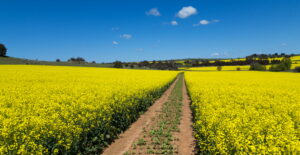The United States Department of Agriculture (USDA) World Agricultural Supply and Demand Estimates (WASDE) Report was released late last week. There was little movement in wheat forecasts, but there were some unexpected increases in corn and soybean markets.
Figure 1 shows only minor changes in global wheat production, consumption, and stocks, however, there were some major movements in specific markets. Russian wheat production was increased by 5mmt, which increased world export stocks. The increase in Russia was largely offset by falls in India and Kazakstan.
India is the world’s second-largest wheat producer, but like the largest, China, it consumes all it grows plus more. The USDA has India’s lower production coming off-ending stocks.
The increase in export stocks from Russia had a negative impact on markets, with CME Soft Red Wheat (SRW) losing much of last week’s gain on Friday.
The wheat balance sheet does remain relatively tight, despite the lift in Russia. Figure 1 tells us ending stocks are forecast 4.0% lower this year, driven by record consumption and lower production (Figure 2).
Prices have the last few years have been skewed, most notably by the Russian invasion of Ukraine last year, so it’s hard to compare supply to price over the last year. Given the balance sheet, however, prices should be somewhere near lows.
Part of the reason for weaker wheat prices is strong corn production. Figure 3 shows corn production is expected to be close to a record this year, with a further lift in the November WASDE. The USDA added 6mmt to corn production this month, with much of it coming in the US, and largely unexpected.
Corn prices declined further on the WASDE report, hitting 464¢/bushels, which in our terms equates to $AU289/t. Corn is the benchmark feed grain, and lower prices will add pressure to our feed grain markets.
World oilseed production was revised upward marginally in the WASDE, but soybeans were relatively steady. The news on oilseeds is the significant lift on last year’s production and ending stocks, as shown in Figure 1. We have seen this increase in oilseed supplies play out in Canola markets, which are much weaker than last year.
What does it mean?
While milling wheat markets are in a holding pattern, as lower supplies are somewhat offset by increasing corn production, there is some downside for feed grains here. Australia is still going to produce an exportable surplus of feed grains, and face price pressure from increasing corn supplies.
Have any questions or comments?
Key Points
- The USDA WASDE increased corn supplies and exportable wheat supplies.
- Grain markets were largely lower on the back of last week’s WASDE.
- The next focus point is South American crops, with others largely secured.
Click on figure to expand
Click on figure to expand
Click on figure to expand
Data sources: USDA, Refinitiv, Mecardo















